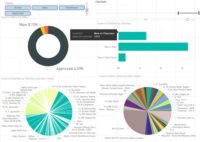Number Two: Hosting Project Models Online Drives Collaboration and Efficiency
The technology that puts the “V” in VDC is the 3D model. A virtual, 3D visual representation of the design that is loaded with attribute data both enriches information exchange and fosters easier collaboration. These models permit design leaders to walk the team through the design.
In the case of a recent plant expansion I managed for a major automobile component manufacturer, after completing such a model walk-through, the owner’s project engineer was so encouraged that he asked for a copy of the model to show his management, instead of having to describe the experience in a written or oral report. In response, design leaders posted the model, as it evolved, every week on their file server.
Those postings had the additional benefit of improving the outcomes of meetings. After viewing the latest version of the model, members of the project team could post their comments. The traditional review process was almost entirely eliminated and the time saved allowed more time for the design team to review the comments before meetings.
At the meetings, no time had to be spent while members of the project team studied the model or while the designers read the comments—they already had. Instead, the team could discuss the comments immediately and work out whatever issues had arisen.
Number Three: Change Orders Are Better Controlled When VDC Reveals Their Full Impact
Midstream changes to scope almost always disrupt the schedule and create unanticipated problems. However, with the help of transparency, collaboration and 3D modeling, the consequences of such changes can be better anticipated, and the changes modified to minimize disruption. In an interactive review, the team gathers around the monitor displaying the model and walks through the proposed change, which leads to questions and drives discussion.
When you concurrently share one model —instead of sending drawings back and forth—the level of understanding among all participants is much higher, and with greater, shared understanding, the team can identify and focus on the underlying issues that hinder improvement.


Post a comment to this article
Report Abusive Comment